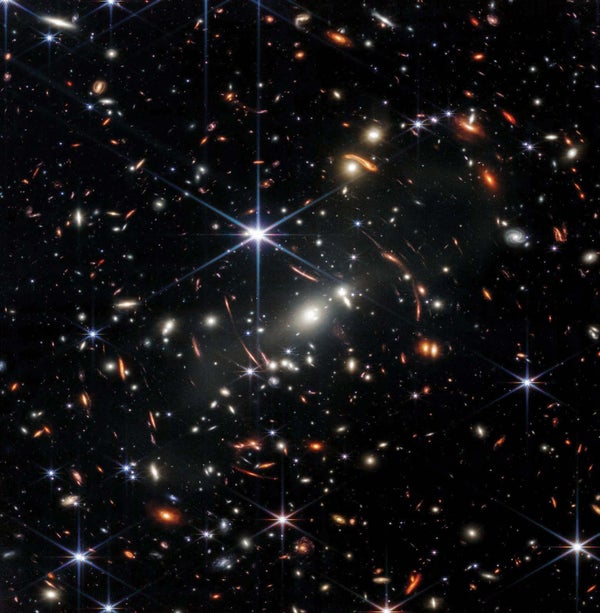Rohan Naidu was at home with his girlfriend when he found the galaxy that nearly broke cosmology. As his algorithm dug through early images from the James Webb Space Telescope (JWST) late one night in July 2022, Naidu shot to attention. It had sifted out an object that Naidu recognized was inexplicably massive and dated back to just 300 million years after the big bang, making it older than any galaxy ever seen before. “I called my girlfriend over right away,” Naidu says. “I told her, ‘This might be the most distant starlight we've ever seen.'” After exchanging excited messages with one of his collaborators “with lots of exclamation marks,” Naidu got to work. Days later they published a paper on the candidate galaxy, which they dubbed “GLASS-z13.” The Internet exploded. “It reverberated around the world,” Naidu says.
The discovery of this galaxy, just weeks into JWST's full operations, was beyond astronomers' wildest dreams. JWST—the largest, most powerful observatory ever launched from Earth—was built to revolutionize our understanding of the universe. Stationed 1.5 million kilometers away from earthly interference and chilled close to absolute zero by its tennis court–sized sunshade, the telescope's giant segmented mirror and exquisitely sensitive instruments were designed to uncover details of cosmic dawn never before observed.
This is the scarcely probed era—no more than a few hundred million years after the big bang itself—in which the very first stars and galaxies coalesced. How exactly this process unfolded depends on exotic physics, ranging from the uncertain influences of dark matter and dark energy to the poorly understood feedbacks between starlight, gas and dust. By glimpsing galaxies from cosmic dawn with JWST, cosmologists can test their knowledge of all these underlying phenomena—either confirming the validity of their best consensus models or revealing gaps in understanding that could herald profound new discoveries.
Such observations were supposed to take time; initial projections estimated the first galaxies would be so small and faint that JWST would find at best a few intriguingly remote candidates in its pilot investigations. Things didn't quite go as planned. Instead, as soon as the telescope's scientists released its very first images of the distant universe, astronomers such as Naidu (at the Massachusetts Institute of Technology) started finding numerous galaxies within them that, in apparent age, size and luminosity, surpassed all predictions. The competition for discovery was fierce: with each new day, it seemed, claims of yet another record-breaking “earliest known galaxy” emerged from one research group or another. “Everyone was freaking out,” says Charlotte Mason, an astrophysicist at the University of Copenhagen. “We really weren't expecting this.”
In the weeks and months following JWST's findings of surprisingly mature “early” galaxies, theorists and observers have been scrambling to explain them. Could the bevy of anomalously big and bright early galaxies be illusory, perhaps because of flaws in analysis of the telescope's initial observations? If genuine, could they somehow be explained by standard cosmological models? Or, just maybe, were they the first hints that the universe is more strange and complex than even our boldest theories had supposed?
At stake is nothing less than our very understanding of how the orderly universe we know emerged from primordial chaos. JWST's early revelations could rewrite the opening chapters of cosmic history, which concern not only distant epochs and faraway galaxies but also our own existence here in the familiar Milky Way. “You build these machines not to confirm the paradigm but to break it,” says JWST scientist Mark McCaughrean, a senior adviser for science and exploration at the European Space Agency. “You just don't know how it will break.”
Deep Looks for Cosmic Dawn
One might say JWST's observations of early galaxies have been billions of years in the making, but more modestly they trace back to the Space Telescope Science Institute (STScI) in 1985. At the time the Hubble Space Telescope was still five years away from launching on a space shuttle. But Garth Illingworth, then deputy director of the STScI, was surprised one day when his boss, then director Riccardo Giacconi, who died in 2018, asked him to start thinking about what would come after Hubble much farther down the road. “I protested, saying we've got more than enough to do on Hubble,” Illingworth recalls. But Giacconi was insistent: “Trust me, it'll take a long time,” he said. So, Illingworth and a handful of others got to work, drawing up concept ideas for what became known as the Next Generation Space Telescope (NGST), later renamed as JWST after a former NASA administrator.
Hubble would be transformational, but astronomers knew its capabilities would be limited by its observations in visible light. As light from a very distant galaxy travels across the cosmic abyss, it is stretched by the expansion of the universe—a broadening of wavelengths known as redshift. The higher the redshift value, the more stretching the light has experienced, and thus the more distant its source galaxy. Redshifts for early galaxies are so high that their emitted visible light has stretched into infrared by the time it arrives at our telescopes, which is why Hubble could not see them. The NGST, for comparison, would observe in infrared and would boast a very large (and very cold) starlight-gathering mirror, allowing it to peer much deeper into the universe. “Everybody realized that Webb would be the telescope for looking at early galaxies,” Illingworth says. “That became the primary science goal.”
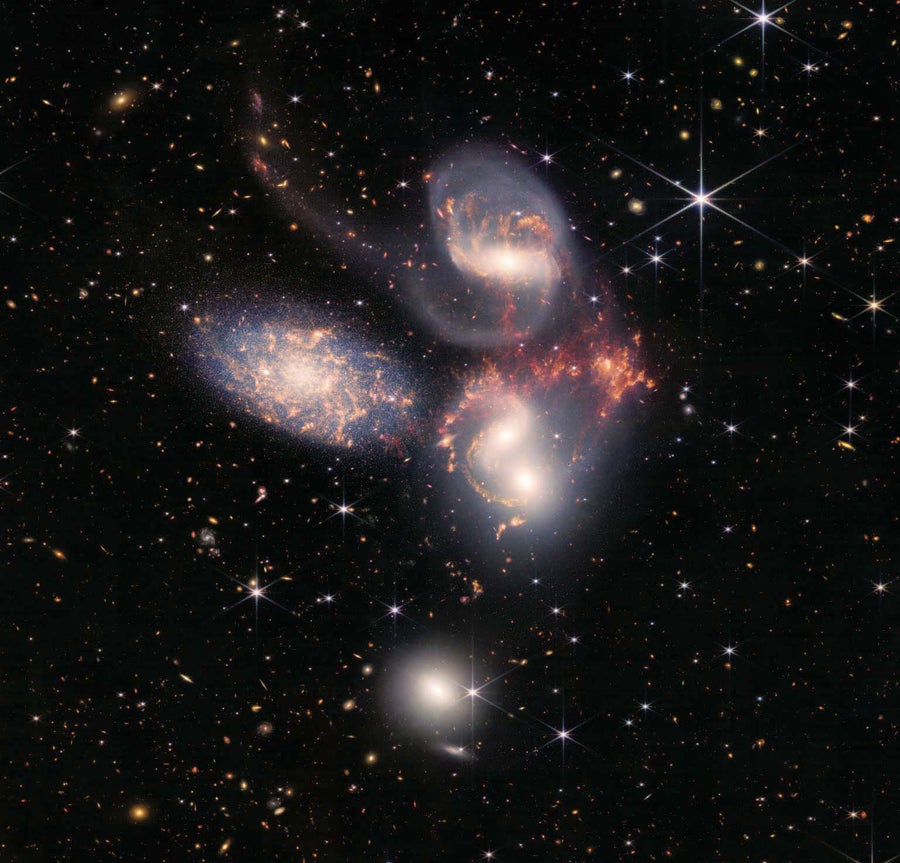
The need for the telescope was highlighted in December 1995, when astronomers pointed Hubble at a seemingly empty patch of the sky for 10 consecutive days. Many experts predicted the extended observation would be a waste of resources, revealing at best a handful of dim galaxies, but instead the effort was richly rewarded. The resulting image, the Hubble Deep Field, showed the “empty” spot was filled with galaxies by the thousands, stretching back 12 billion years into the 13.8-billion-year history of our universe. “There were galaxies everywhere,” says Illingworth, now an astrophysicist at the University of California, Santa Cruz. The Hubble Deep Field showed that the early universe was even more crowded and exciting than most anyone had expected, offering observational treasures to those who took the time and care to properly look. Yet, impressive as Hubble's Deep Field was, astronomers wanted more.
After more than two decades of labor at a cost of some $10 billion, JWST finally launched on Christmas Day 2021. The telescope reached its deep-space destination a month later, where it would endure exhaustive testing to ensure its optimal performance. By July 2022 it was ready to begin its long-awaited first year of science observations, known as Cycle 1. Part of the telescope's early time was devoted to high-impact programs across a range of disciplines from which data would immediately be made public. Two of those, CEERS (the Cosmic Evolution Early Release Science Survey) and GLASS (the Grism Lens–Amplified Survey from Space), independently spent dozens of hours looking for galaxies in the early universe by staring at separate small portions of the sky. Not much was expected—perhaps a slightly more ornate version of the Hubble Deep Field but nothing more. Steven Finkelstein of the University of Texas at Austin, the lead on CEERS, says extremely distant galaxies were predicted to pop up only “after a few cycles of data” from multiple programs.
Instead, much to the surprise of astronomers, extremely distant galaxies came into view immediately. Hubble's record for the most distant known galaxy had been GN-z11, spotted in 2015 at a redshift of 11 thanks to a 2009 upgrade that enhanced the telescope's modest infrared capabilities. A redshift of 11 corresponds to a cosmic age of about 400 million years, a point at the brink of when galaxy formation was thought to begin. But from the very first GLASS data, two teams—one led by Naidu in that breathless late-night discovery—independently found GLASS-z13 at a redshift of 13, some 70 million years farther back in time.
In their quest for quick results, the researchers relied on redshift estimates derived from simple brightness-based measurements. These are easier to obtain but less precise than direct measurements of redshift, which require more dedicated observation time. Nevertheless, the simplified technique can be accurate, and here it suggested a galaxy that was unexpectedly bright and big, already bearing a mass of stars equivalent to a billion suns, just a few hundred times less than that of the Milky Way's stellar population, despite our own galaxy being billions of years more mature. “This was beyond our most optimistic expectations,” says Tommaso Treu, an astronomer at the University of California, Los Angeles, and the lead on GLASS.
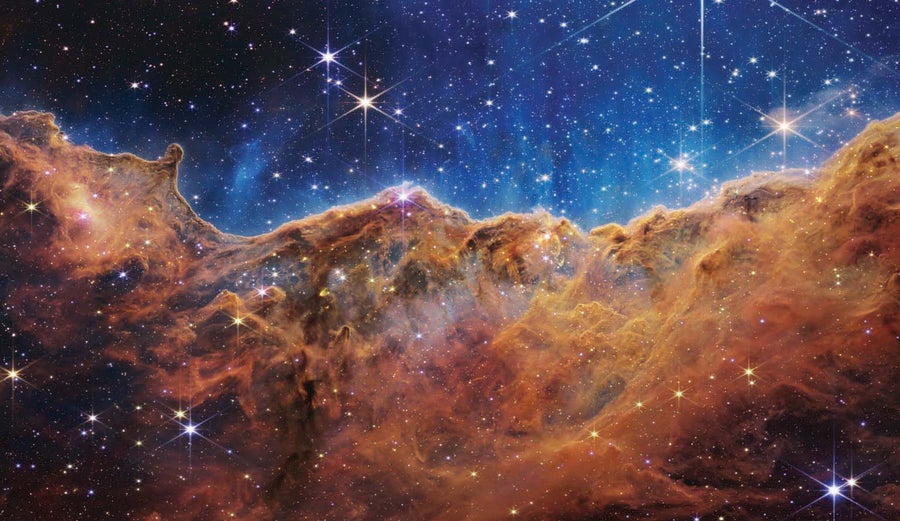
The record didn't last long. In the following days, dozens of galaxy candidates from CEERS and GLASS sprang into view with estimated redshifts as high as 20—just 180 million years after the big bang—some with disklike structures that were not expected to manifest so early in cosmic history. Another team, meanwhile, found evidence for galaxies the size of our Milky Way at a redshift of 10, less than 500 million years after the big bang.
Such behemoths emerging so rapidly defies expectations set by cosmologists' standard model of the universe's evolution. Called Lambda CDM (LCDM), this model incorporates scientists' best estimates for the properties of dark energy and dark matter, which collectively act to dominate the emergence of large-scale cosmic structures. (“Lambda” refers to dark energy, and “CDM” refers to dark matter that is relatively sluggish, or “cold.”) “Even if you took everything that was available to form stars and snapped your fingers instantaneously, you still wouldn't be able to get that big that early,” says Michael Boylan-Kolchin, a cosmologist at the University of Texas at Austin. “It would be a real revolution.”
How to Build a Galaxy
To understand the dilemma, a brief refresher is needed. In the first second after the big bang, our universe was an almost inconceivably hot and dense soup of primordial particles. Over the next three minutes, as the cosmos expanded and cooled, the nuclei of helium and other very light elements began to form. Fast-forward 400,000 years, and the universe was cold enough for the first atoms to appear. When the universe was about 100 million years old, theorists say, conditions were finally right for the emergence of the first stars. These giant fireballs of mostly hydrogen and helium were uncontaminated by heavier elements found in modern-day stars, so they possessed significantly different properties. Larger and brighter than today's stars, these first suns coalesced in protogalaxies—clusters of gas that clung to vast, invisible scaffolds of dark matter. Gravity guided the subsequent interactions between these protogalaxies, which eventually merged to form larger galaxies. This process of becoming, of the early universe's chaos giving way to the more orderly cosmos we know today, is thought to have taken about a billion years.
JWST's discovery of bright galaxies in the early cosmos challenges this model. “We should see lots of these little protogalactic fragments that have not yet merged to make a big galaxy,” says Stacy McGaugh, a cosmologist at Case Western Reserve University. “Instead we're seeing a few things that are already big galaxies.” Some of these galaxies may be impostors, much closer galaxies shrouded in dust that makes them look dimmer and farther away when brightness-based measurements are used. Follow-up observations of GLASS-z13 in August 2022 by the Atacama Large Millimeter Array (ALMA) in Chile, however, suggest that is not the case for this candidate, because ALMA did not see evidence for large amounts of dust. “I think we can exclude low-redshift interlopers,” says Tom Bakx, an astronomer at Nagoya University in Japan, who led the observations. Yet the lack of dust means ALMA struggled to see the galaxy at all, showing how difficult it could be for telescopes to confirm observations made using JWST's advanced capabilities. “The good news is there's nothing detected,” Naidu says. “The bad news is there's nothing detected.” Only JWST, in this case, can follow up itself.
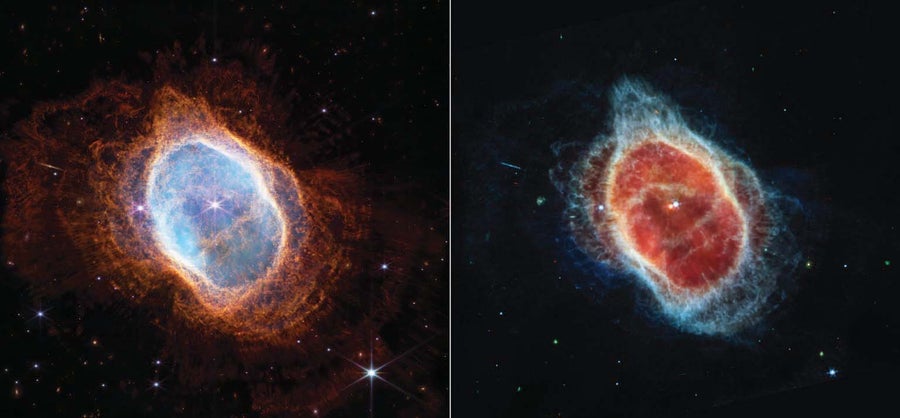
The most startling explanation is that the canonical LCDM cosmological model is wrong and requires revision. “These results are very surprising and hard to get in our standard model of cosmology,” Boylan-Kolchin says. “And it's probably not a small change. We'd have to go back to the drawing board.” One controversial idea is modified Newtonian dynamics (MOND), which posits that dark matter does not exist and that its effects can instead be explained by large-scale fluctuations in gravity. To date, JWST's observations could support such a theory. “MOND has had a lot of its predictions come true—this is another one of them,” says McGaugh, who is one of the idea's leading proponents. Others remain unconvinced. “So far everything that we've tried to test MOND hasn't been able to really provide a satisfactory answer,” says Jeyhan Kartaltepe, an astrophysicist at the Rochester Institute of Technology.
One simpler solution is that galaxies in the early universe could have little or no dust, making them appear brighter. This scenario could confound efforts to calculate the galaxies' true masses and could perhaps also explain ALMA's difficulty spotting GLASS-z13. “It could be that supernovae didn't have enough time to produce the dust, or maybe in the initial phases [of galaxy formation] the dust is expelled from galaxies,” says Andrea Ferrara, an astronomer at the Scuola Normale Superiore in Italy, who has proposed such a possibility. Alternatively, Mason and her colleagues suggest that in its observations of the early universe JWST may so far be seeing only the very brightest young galaxies, as they should be the easiest to spot. “Maybe there's something happening in the early universe that means it's easier for some galaxies to form stars,” she says.
David Spergel, a theoretical astrophysicist and current president of the Simons Foundation in New York City, agrees. “I think what we're seeing is that high-mass star formation is very efficient in the early universe,” he says. “The gas pressures are higher. The temperatures are higher. That has an enormous impact on the environment for star formation.” Magnetic fields might have arisen earlier in the universe than we thought, driving material to kick-start the birth of stars. “We might be seeing a signature of magnetic fields emerging very early in the universe's history,” Spergel says.
A Rush to Break the Universe
The rapid flow of scientific papers from JWST's initial observations is no fluke; when the first data arrived, astronomers were eagerly waiting. “People had been working on their pipelines for years,” Boylan-Kolchin says. Instead of the traditional peer-review process, which can take months, astronomers published on arXiv, a website where scientific papers can be uploaded after minimal review by moderators but well before formal peer review. This new form of review is unfolding in near real time on X (formerly Twitter) and other social media platforms. “It's science by arXiv,” Naidu says. The resulting frenzy was intense—and surprising. “I expected a lot of activity,” says Nancy Levenson, STScI's interim director. “But I underestimated the amount.”
The result was that scientific results could be rapidly publicized and discussed, but some fear at a cost. “People were rushing things a little bit,” says Klaus Pontoppidan, JWST's project scientist at STScI. “The gold standard is a refereed, peer-reviewed paper.” Early calibration issues with JWST, for example, may have affected some results. Nathan Adams of the University of Manchester in England and his colleagues found there could be dramatic changes, with one galaxy at a redshift of 20.4 recalibrated to a redshift of just 0.7. “We need to calm down a little bit,” Adams says. “It's a bit too early to say we've completely broken the universe.”
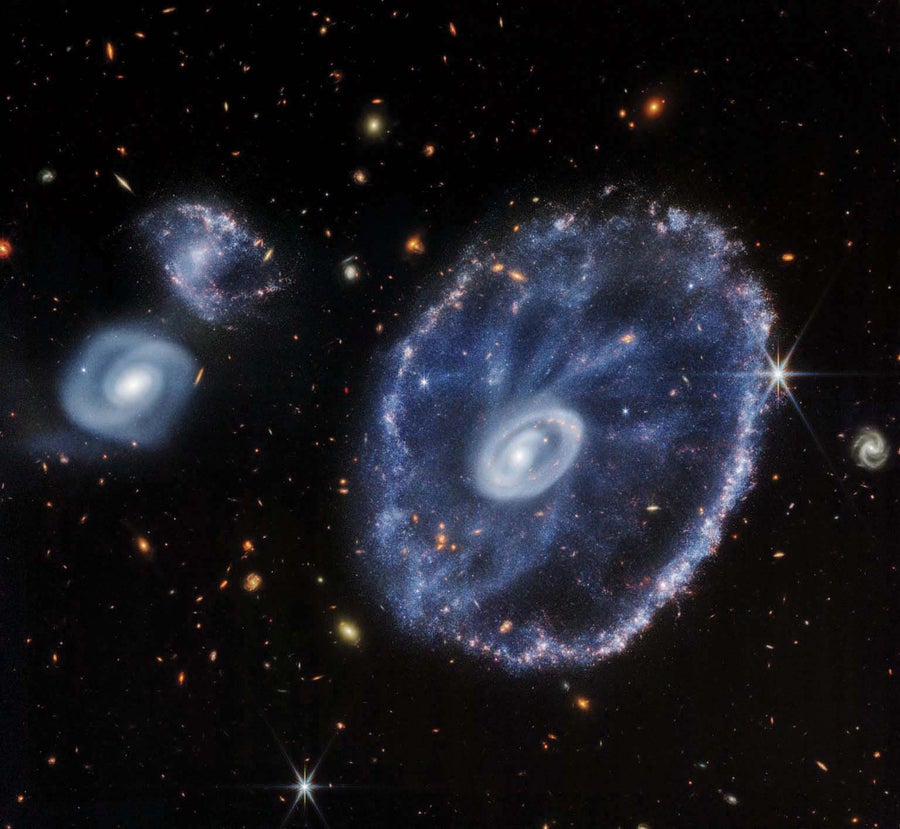
Such issues are unlikely to eradicate all of JWST's high-redshift galaxies, however, given their sheer number. “It's more likely that the early universe is different from what we predicted,” Finkelstein says. “The odds are small that we're all wrong.” Astronomers are now racing to conduct follow-up observations with JWST. Levenson says she's currently reviewing about a dozen proposals from various groups asking for additional JWST observing time, most of which are seeking to scrutinize high-redshift galaxy candidates. “Considering the excitement and importance of these early discoveries, we thought it was appropriate to ask for a little bit of time to confirm them,” says Treu, who put forward one of the proposals.
More programs have been designed to hunt for distant galaxies, such as COSMOS-Webb, co-led by Kartaltepe, which aims to hugely increase the known population of early galaxies by observing a wider swath of sky for hundreds of hours. “We estimate there are thousands we'll be able to detect,” she says. Future proposals might look for evidence of those first protogalaxies, perhaps using the explosive deaths of supersized first stars in especially luminous and energetic supernovae as markers for their existence. Some estimates suggest JWST could see as far as a redshift of 26, just 120 million years after the big bang, a cosmic blink of an eye. Much other work will be done to follow up the growing list of high-redshift candidates. “Even confirming a handful of these would be quite amazing,” Naidu says. “It would demonstrate we're not getting fooled.”
JWST has ushered in a new era of science, and despite the uncertainties, the rapid communication of new discoveries has invigorated astronomers. “It's been fantastic,” Treu says. “It's really wonderful to see the community so engaged and excited.” Now the question is, If we can truly believe what we are seeing, is it time to reappraise our understanding of the dawn of time? “We're peering into the unknown,” Mason says.
